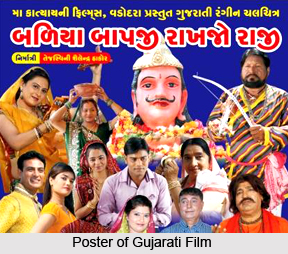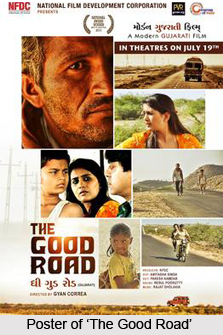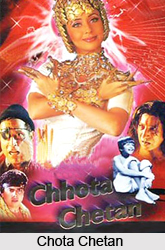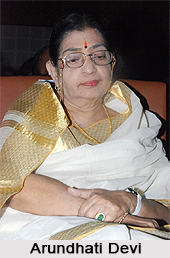 Gujarati cinema, the regional film industry of Gujarat, started its journey in 1922. Since then the Gujarati films immensely contributed to the Indian cinema. Gujarati cinema has gained popularity among the regional film industry in India. Gujarati cinema is always based on scripts from mythology to history and social to political. Since its origin Gujarati cinema has experimented with various stories and issues from the Indian society. Furthermore, Gujarat has immense contribution to the Bollywood as several Gujarati actors have brought glamour to the Indian film industry.
Gujarati cinema, the regional film industry of Gujarat, started its journey in 1922. Since then the Gujarati films immensely contributed to the Indian cinema. Gujarati cinema has gained popularity among the regional film industry in India. Gujarati cinema is always based on scripts from mythology to history and social to political. Since its origin Gujarati cinema has experimented with various stories and issues from the Indian society. Furthermore, Gujarat has immense contribution to the Bollywood as several Gujarati actors have brought glamour to the Indian film industry.
Gujarati cinema has seen growth and diversification in its content, with films spanning various genres, including drama, comedy, romance, social issues, and historical narratives. Notable Gujarati actors, directors, and producers have contributed to the industry`s progress, further establishing its significance within the Indian film landscape. In recent years, there has been a resurgence of interest in Gujarati cinema, with filmmakers exploring innovative storytelling approaches and tapping into contemporary issues relevant to the state and its people. This revival has attracted both new talent and investment in the industry, promising a bright future for Dhollywood in the years to come.
Etymology of Gujarati cinema
Gujarati cinema, often referred to as "Dhollywood" or "Gollywood," draws inspiration from its counterpart, Bollywood, which is the Hindi language film industry centered in Mumbai, formerly known as Bombay. The sobriquet "Dhollywood" stems from the prominent use of the dhol, a traditional double-headed drum, in Gujarati film productions. Additionally, the term "Gollywood" is a portmanteau formed by combining "Gujarat" and "Bollywood," symbolizing the industry`s connection to its Hindi-language counterpart.
The Gujarati film industry has evolved over the years, establishing its own identity while retaining certain elements reminiscent of Bollywood. This regional film industry has contributed significantly to the cultural landscape of Gujarat and has garnered a dedicated audience both within the state and among the Gujarati diaspora worldwide.
The influence of Bollywood on Gujarati cinema can be observed not only in its nomenclature but also in certain thematic elements, song and dance sequences, and storytelling techniques. However, Dhollywood has also developed its unique characteristics and narrative styles, reflecting the rich cultural heritage and traditions of Gujarat.
History of Gujarati Cinema
The history of Gujarati cinema can be traced back to its silent film era, which spanned from 1913 to 1931. During this period, numerous silent films closely aligned with the Gujarati culture and people were produced. Notably, many directors, producers, and actors associated with these films were of Gujarati and Parsi origin. Bombay (now Mumbai) emerged as a hub for Gujarati cinema, hosting approximately twenty prominent film companies and studios, with at least forty-four accomplished Gujarati directors.
Gujarati Cinema in Silent Film Era
One noteworthy silent film from this era was "Bilwamangal" (also known as "Bhagat Soordas," 1919), directed by Rustomji Dhotiwala, a Parsi Gujarati, based on a story by Gujarati writer Champshi Udeshi. This substantial production, running at 132 minutes or 12,000 feet in length, was produced by the Elphinstone Bioscope Company of Calcutta (now Kolkata) and is typically categorized as Bengali in origin.
In 1919, Suchet Singh, with the assistance of Hajimahamad Allarakha, the editor of the popular Gujarati magazine "Visami Sadi," founded the Oriental Film Manufacturing Company of Bombay. One of Oriental`s significant contributions was the silent film "Narsinh Mehta" (1920), featuring the Gujarati song "Vaishnav Jan To," which became a popular sing-along piece in cinema halls.
Dwarkadas Sampat, an early Gujarati film producer, initiated his involvement with the film industry in Rajkot by organizing film shows using a projector. He later co-founded Patankar Friends & Company with S. N. Patankar for film production. The Krishna Film Company, established in 1924 and owned by Maneklal Patel, was responsible for producing a remarkable forty-four films between 1925 and 1931. Additionally, the Sharda Film Company, financed by Mayashankar Bhatt and managed by Bhogilal Dave and Nanubhai Desai, made its mark in 1925. Mayashankar Bhatt also provided financial backing to Dadasaheb Phalke`s Hindustan Cinema Film Company.
The transition to early talkies in Gujarati cinema commenced in 1932, just before the release of India`s first full-length sound film, "Alam Ara." On February 4, 1931, a short Gujarati sound film titled "Chav Chavno Murabbo" was released in Bombay. It featured the song "Mane Mankad Karde," marking the first use of sound in any Indian film. The film was produced by Maneklal Patel, with lyrics and dialogue by Natwar Shyam.
Before the release of the first full-length Gujarati sound film, two short Gujarati sound films were introduced alongside Hindi talkies. "Krishna–Sudama," a two-reel short produced by the Imperial Film Company, premiered with the Hindi talkie "Nek Abala." Another two-reel short titled "Mumbai ni Shethani" was presented alongside "Shirin Farhad" on January 9, 1932, at Wellington Cinema, Bombay. This film, produced by Theatres of Calcutta, was based on a story by Champshi Udeshi and featured the Gujarati song "Fashion ni Fishiari, Juo, Mumbai ni Shethani."
Gujarati Cinema in Early Talkies Era
The pivotal moment in the history of Gujarati cinema arrived on April 9, 1932, with the release of the first full-length Gujarati talkie, "Narsinh Mehta." Directed by Nanubhai Vakil, produced by Sagar Movietone, and starring Mohanlala, Marutirao, Master Manhar, and Miss Mehtab, this film marked the true inception of Gujarati cinema. It centered around the life of the saint Narsinh Mehta.
Subsequently, in 1932, "Sati Savitri," based on the epic tale of Savitri and Satyavan followed suit. In 1935, the comedy "Ghar Jamai," directed by Homi Master, graced the screens, featuring an ensemble cast that included Heera, Jamna, Baby Nurjehan, Amoo, Alimiya, Jamshedji, and Gulam Rasool. "Ghar Jamai" explored the theme of a resident son-in-law and his amusing escapades, shedding light on the evolving social attitudes towards the freedom of women.
Gujarati Cinema in Post-Independence Era
After independence, the industry continued to flourish, with seventy-four films produced between 1946 and 1952. These films often drew inspiration from myths and folktales, resonating with the audience`s cultural heritage. Notable films from this era include "Ranakdevi" (1946), "Meerabai" (1946), and "Gunsundari" (1948).
The period from 1951 to 1970 witnessed a decline in film production, with only fifty-five films produced during this time. However, some remarkable films like "Malela Jeev" (1956), "Kanku" (1969), and "Jigar ane Ami" (1970) made significant contributions to Gujarati cinema.
Rise and Decline of Gujarati Cinema
The establishment of separate linguistic states, Gujarat and Maharashtra, in 1960 significantly impacted Gujarati cinema. The industry faced challenges due to the absence of major production houses and studios in Gujarat, leading to a decline in both the quantity and quality of films. In the 1970s, the government of Gujarat introduced subsidies and tax exemptions to revive the industry. While this resulted in increased film production, it also led to a proliferation of films without adequate technical or artistic merit. Films focused on deities and dacoits became prevalent during this time. Low budget films with compromised quality targeted rural audiences while urban audiences moved to television and Bollywood films with quality content.
Revival of Gujarati Cinema
The revival of Gujarati cinema in the early 2000s marked a significant turning point for the industry, which had seen a decline in production to fewer than twenty films annually. The catalyst for this revival was a series of governmental initiatives aimed at incentivizing and supporting the Gujarati film industry.
In 2005, the government of Gujarat took a substantial step by announcing a 100% entertainment tax exemption for films certified as U and U/A, along with a 20% tax rate for A certified films. Additionally, a Rupees 5 lakh subsidy for Gujarati films was introduced. These measures breathed new life into the industry, particularly in rural north Gujarat, notably the Banaskantha district. The impact of these incentives was palpable, with the number of films produced annually surpassing sixty in 2009 and 2010. The zenith was reached in 2012 when a record seventy-two Gujarati films were released. "Maiyar Ma Mandu Nathi Lagtu" (2001), directed by Jashwant Gangani and starring Hiten Kumar, played a pivotal role in this resurgence and saw a sequel released in 2008.
However, in August 2013, the subsidy by the Government of Gujarat was discontinued, posing challenges for sustaining this growth. Nevertheless, a fresh incentive policy was introduced in February 2016, with a focus on film quality. Films were graded into four categories (A to D) based on technical aspects, production quality, film components, and box office performance. Additional incentives were provided for films that performed well at festivals and received nominations or awards. Multiplexes were also directed to screen a minimum of forty-nine Gujarati films annually.
Despite the discontinuation of entertainment tax exemptions for Gujarati films with the introduction of the Goods and Services Tax in July 2017, the industry continued to prosper. This was attributed to improvements in production quality, increased use of technology, enhanced film marketing strategies, and the exploration of new subjects targeted at a younger audience. Between 2016 and 2018, approximately 50 to 70 films were released each year, signifying a sustained resurgence. Notably, the International Gujarati Film Festival made its debut in New Jersey, USA, in August 2018, further highlighting the global recognition of Gujarati cinema.
Gujarati cinema achieved significant milestones with films such as "Wrong Side Raju" (2016), "Dhh" (2017), "Reva" (2018), and "Hellaro" (2019) winning accolades at the National Film Awards. "Hellaro" notably became the first Gujarati film to secure the National Film Award for Best Feature Film at the 66th National Film Awards. "Chaal Jeevi Laiye!" (2019) also left a lasting impact by becoming the highest-grossing film in the history of Gujarati cinema.
Dominant Themes in Gujarati Cinema
Gujarati cinema, like its counterparts, has explored a diverse range of subjects and themes over its rich history. These cinematic narratives reflect the cultural nuances, human aspirations, and family-centric values that are deeply ingrained in Gujarati society. Thematic evolution of Gujarati cinema is described below.
Family and Relationships: A lifeline of Gujarati cinema, many films revolve around family dynamics and relationships. These narratives often explore the intricacies of familial bonds, showcasing the cultural significance of the family unit in Gujarati society.
Human Aspirations: Gujarati cinema delves into the aspirations and dreams of its characters. These films often portray individuals striving to achieve their goals, whether personal or professional, offering a reflection of human ambition and perseverance.
Gujarati Family Culture: The unique culture of Gujarati families is a recurrent theme. Films capture the traditions, values, and rituals that shape the lives of Gujarati families, providing an intimate glimpse into their way of life.
Mythological and Folklore: In its early years, Gujarati cinema embraced mythological narratives and folklore. These films drew inspiration from ancient tales and legends, bringing them to life on the silver screen and connecting with the cultural heritage of the audience.
Social Reforms: The medium has also been a platform for addressing social issues and advocating for reforms. Films centered on topics like family life, marriage, and societal changes have contributed to meaningful discussions and awareness. . In 1935, a social movie, Ghar Jamai, was released, directed by Homi Master. The film starred Heera, Jamna, Baby Nurjehan, Amoo, Alimiya, Jamshedji, and Gulam Rasool. The film featured a Resident Son-In-Law or Ghar Jamai, and his escapades as well as his problematic attitude towards the freedom of women. It was a comedy oriented movie and was a major success in the industry.
Historical and Religious Subjects: Historical, social, and religious themes dominated Gujarati cinema during the 1940s and 1950s. These films explored historical events, religious figures, and societal transformations.
Literary Adaptations: Many Gujarati films have been adapted from novels and stories written in the Gujarati language. These adaptations capture the essence of the original literary works, bridging the gap between literature and cinema.
Saint and Sati Films: The 1970s witnessed a resurgence of films focused on saintly figures and the practice of sati. These movies delved into the spiritual and cultural aspects of Gujarati society. The first Gujarati movie, Narasinh Mehta starred Mohanlala, Marutirao, Master Manhar, and Miss Mehtab. It was of the Saint Film genre and was on the life of the saint Narasinh Mehta who observed a creed that was followed centuries later by Mahatma Gandhi. The film was matchless as it avoided any depiction of miracles.
Influence of Hindi Cinema: In the 1980s and 1990s, Gujarati cinema felt the influence of Hindi cinema, resulting in the production of action-packed and romantic films. This period saw a blend of styles from both industries.
Rural and Urban Subjects: The early 2000s brought about a shift in focus, with films primarily targeting rural audiences. These narratives often featured local stories and linguistic styles, catering to the tastes of rural viewers. Post-2005, urban subjects took center stage, leading to a revival of Gujarati cinema. This shift broadened the appeal of Gujarati films and attracted a more diverse audience.
Contemporary Relevance: In the 2010s, Gujarati cinema adapted to changing societal dynamics, producing films that resonate with modern audiences. While comedies continued to thrive, other genres and themes were explored to cater to diverse tastes.
Golden Era in Gujarati Cinema
The period from 1965 to 1990 was considered as the Golden Era in Gujarati Cinema. Gujarati films thus proceeded with several other important social, political as well as religious issues. The years 1948, 1950, 1968, 1971 moved with a wide variety of dimension. The Gujarati movies such as Kariyavar, directed by Chaturbhuj Doshi, Vadilona Vanke directed by Ramchandra Thakur, Gadano Bel, directed by Ratibhai Punatar and Leeludi Dharti, directed by Vallabh Choksi, and brought immense success to the industry. The problems of modernisation are the underlying concern of several films. The movies like Gadano Bel had a strong realism and reformism.
The film industry in Gujarat experimented with various issues. Gujarati films such as Leeludi Dharti reflect the rural world with its fertility rituals. In 1975 Tanariri, directed by Chandrakant Sangani presents highlights the little known side of Akbar who is usually presented as a consistently benign ruler. The first cinemascope film of Gujarati cinema was Sonbaini Chundadi, directed by Girish Manukant released in the year 1976. Besides these, Bhavni Bhavai, released in the year 1980, was directed by Ketan Mehta. It boasted of superlative performances, fine camerawork and won two awards, National Award for Best Feature Film on National Integration, and another award at the Nantes festival in France. In 1992, Hun Hunshi Hunshilal, directed by Sanjiv Shah was sought to be post-modern.
Challenges and Changing Demographics:
Despite periodic surges in production, the industry faced challenges in adapting to changing times, technology, and demographics. Low-budget films aimed at rural audiences compromised on quality, while urban viewers turned to television and Bollywood for content with broader appeal.
By 1981, 368 Gujarati feature films and 3,562 Gujarati short films had been produced. The Gujarat Film Development Corporation (GFDC), established to promote Gujarati cinema, ceased its operations in 1998.
Notable Films and Personalities:
Several notable films and personalities eme
rged during this period. "Bhavni Bhavai" (1980), directed by Ketan Mehta, garnered acclaim for its artistic and aesthetic qualities. Avinash Vyas, a major composer in Gujarati cinema, contributed to 168 Gujarati films and 61 Hindi films. His son, Gaurang Vyas, composed music for "Bhavni Bhavai."
Actors of Gujarati Films
Gujarati films were further enriched by the brilliant performances of the film personalities. Anupama, Upendra Trivedi, Arvind Trivedi, Ramesh Mehta and Veljibhai Gajjar, Dilip Patel, Ranjitraj, Sohil Virani, Narayan Rajgor, Premshankar Bhatt, Jay Patel, Ashvin Patel, Girija Mitra, Anjana, Manmohan Desai, Sanjay Gadhvi, Kalyanji Anandji, Deepika Chikhalia, Bindu Desai, Renuka Shahane and Priti Parekh are the celebrated actors who have contributed a lot to the Gujarati film industry.
Archive of Gujarati Cinema
In Gujarati cinema, a medium that has seen significant growth and transformation since its inception in 1932, the status of film archiving is a topic of concern. Between 1932 and 2011, approximately one thousand and thirty Gujarati films were produced. However, the archival record of this cinematic legacy remains sparse. At the National Film Archive of India (NFAI), the custodian of India`s cinematic heritage, only a limited number of Gujarati films have found their place in the archives. Specifically, a mere twenty Gujarati films, which includes two Parsi-Gujarati productions, have been archived to date.
Remarkably, the archived Gujarati films include "Pestoneei" (1987), directed by Vijaya Mehta, and "Percy" (1989), directed by Pervez Merwanji. These films have been recognized for their cultural and artistic significance, earning their place within the preserved cinematic heritage. Regrettably, the archival landscape reveals a significant gap when it comes to silent films and talkies from the 1930s and 1940s, as none have survived within the NFAI archives.






